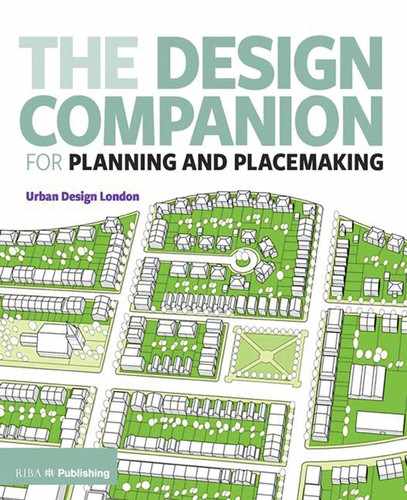12
Historic environment
Rather than being a constraint on design and development, the heritage of a place is an irreplaceable resource to be managed to create an even better place (see Figure 12.1). In many local planning authorities that have historic centres or significant heritage interest, historic environment policies form an important part of their approach to managing development and delivering positive change. Others may see managing the historic environment as less central to day-to-day planning. However, it is rare in this country to find a site, be it greenfield or brownfield, where there is no evidence of previous human presence.
The NPPF and PPG advocate the need for all local planning authorities to include in their local plans a positive strategy for the conservation and enjoyment of the historic environment. To do this, local planning authorities need to identify what those heritage interests are, and the contribution they make and could continue to provide through new developments to a place’s social, cultural, environmental and economic wellbeing.
Attitudes have changed since the 1970s. We look back, bewildered, wondering why anyone would have thought they could get away with redeveloping Covent Garden, or demolishing part of Bloomsbury to accommodate the British Library rather than using former railway land at Kings Cross (ideas that were thankfully never implemented).
The challenge remains to strike the right balance between conservation and introducing new forms of development. Understanding and responding to historic significance is a key to making successful and sustainable places. The economic and resource-efficient value of heritage is clear, as are the historic environment’s benefits to people’s wellbeing and sense of place. Today, many planners talk about ‘the management of continuity’ in relation to conservation, rather than ‘the management of change’. This helps to emphasise incremental change and the need for development to establish a clear relationship with what has gone before.
Urban Design Meets Heritage
The forerunners of today’s urban design literature, such as Gordon Cullen’s The Concise Townscape (1971), used visual analysis of our historic towns to show how buildings and spaces combined to make attractive places. Urban design has learnt from the success of architects and placemakers who have gone before and our historic cities, towns and villages have shown how appropriate layout, scale, density, materials and detail can contribute to creating development characterised by a rich mix of uses and activities, fitness for purpose, successful movement, attractive spaces, adaptability, efficiency and attractive appearance. Since Cullen’s time, information about successfully managing historic environments, and specifically heritage assets, has become much more widely available, linking heritage and urban design approaches. This helps with analysing the heritage significance of a place, and applying that analysis.
Figure 12.2 shows The Pantiles, Royal Tunbridge Wells, whose fine-grained mix of buildings and arcades contributes to the town’s distinctiveness. Even small changes to the shopfronts and upper floors could erode its special character.
The Changing Language of Conservation
When dealing with heritage, it is useful for planners to understand and use the official terminology. For example, the term ‘heritage assets’ is used collectively to describe all features in the historic environment that are identified as having heritage interest, and which should be taken into

Figure 12.1
Northampton Guildhall: a Grade II*-listed building that contributes greatly to the character and quality of the place.
Figure 12.2 The Pantiles: Royal Tunbridge Wells.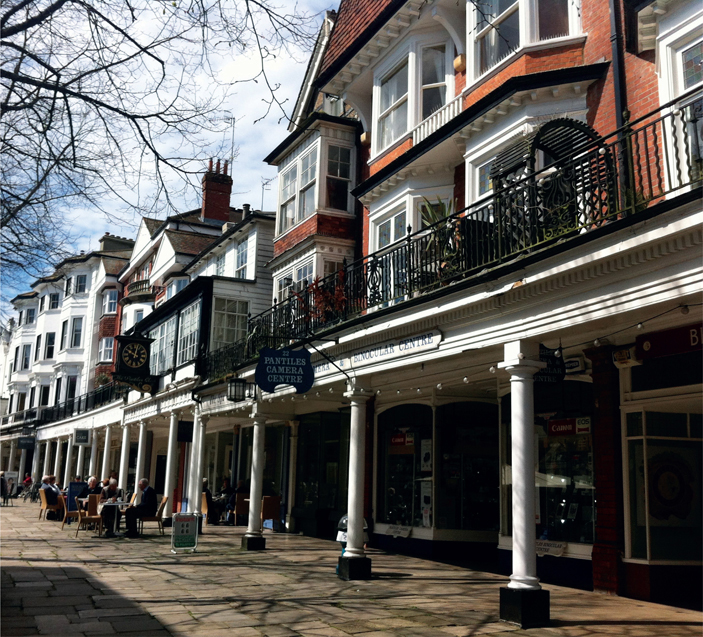
account when considering a planning proposal. This can include ‘designated’ heritage assets such as world heritage sites, listed buildings, conservation areas, scheduled ancient monuments, registered parks and gardens, protected wrecks and battlefields; and non-designated assets identified by local planning authorities, which could include locally listed buildings and other features of local importance. The use of the term ‘significance’ has also become increasingly important in analysing buildings, sites and areas; read on for advice as to what this means. In evaluating development, ‘impact’ and ‘harm’ are also now parts of the recognised language of heritage.

Figure 12.3
Corsham Court, Wiltshire. This Grade I-listed country house is situated in an 18th-century Grade II*-registered park, which was improved by Capability Brown. A walled garden in the park contains an early-18th-century gazebo.
What the NPPF Says
‘The historic environment is ‘all aspects of the environment resulting from the interaction between people and places through time, including all surviving physical remains of past human activity, whether visible, buried or submerged, and landscaped and planted or managed flora.’ Any analysis should cover all aspects of heritage, from the physical to the cultural.
Significance
NPPF policy on the conservation of the historic environment is based on the concept of significance, which is defined as ‘the value of a heritage asset to this and future generations because of its heritage interest’. It is important to note that significance derives not only from a heritage asset’s physical presence, but also from its setting.
The NPPF defines the components of heritage interest as archaeological, architectural, artistic or historic. Historic England’s Conservation Principles, Policies and Guidance16 uses slightly different terminology but explores the same issues in more detail.
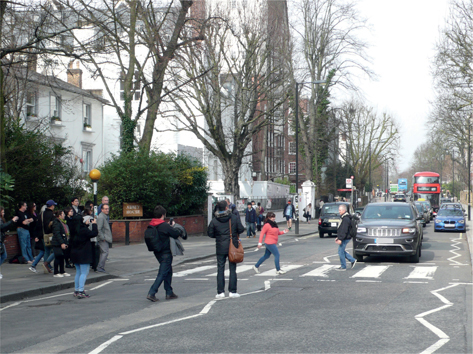
Figure 12.4
Abbey Road zebra crossing in London, famous from the cover of The Beatles’ album of the same name, was listed in recognition of its cultural and communal value.
Historic England provides supporting information for the interpretation and practical application of NPPF policy.17 Although some NPPF terms may seem better suited to historic buildings or sites rather than more extensive heritage assets such as conservation areas, Historic England’s advice on characterisation can be applied to understanding the significance of conservation areas. It is here that urban design and conservation approaches come together. The quality of a place is defined not only by its heritage, but also by its urban design qualities. Recognising the overlap and the additional values in the wider townscape and landscape is often an important dimension in the art of conservation.
The more recent changes brought forward in the NPPF suggest a mismatch between current policy and guidance, and the terms used in the relevant legislation. This can be broadly explained by understanding that significance equates to special architectural and historic interest in relation to listed buildings, and to character or appearance in relation to conservation areas. This approach should be applied to all forms of heritage management, from policy formulation to the consideration of development proposals.
Significance can be derived from more than just buildings. Connections with people or events can also make a place special, as with the zebra crossing on Abbey Road, famous for its association with The Beatles (Figure 12.4).
The evidence base
As in all aspects of planning, the earlier the evidence base is assembled, the better. In any local authority, the statutory designations of heritage assets should be well documented, be they listed buildings or conservation areas. There may also be local lists and archaeological information contained in a Historic Environment Record service. Ideally, all this information will be brought together and analysed in planning, and included in local or neighbourhood plans. It should be supplemented by a historic environment strategy, and by conservation area appraisals and management plans. Analysis may be at different levels, from area-based characterisation to the detailed analysis of the importance of a listed building. In London, for example, borough-wide characterisation studies provide extensive coverage across many areas of the capital, including areas of development opportunity. These provide essential information for local and strategic planning.
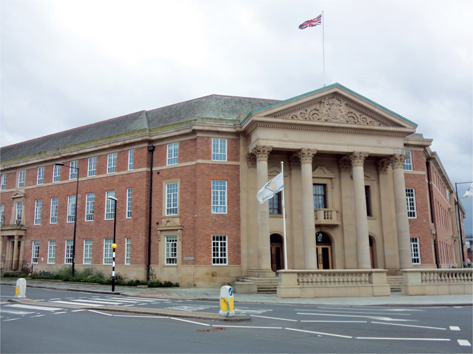
Figure 12.5 Derby Council House (1948), locally listed.
In many cases there is no adequate evidence base, and further research and analysis will often be necessary in the early stages of preparing a planning brief, masterplan or planning application. Fortunately there is ample guidance on the subject (such as Historic Environment Good Practice in Planning Advice Note 118 and Historic England Advice Note 319). The earlier in the process this exercise takes place the better for the quality of the decision-making. Suspicions are immediately raised among elected members and amenity organisations when a heritage appraisal appears to have been retrofitted to support a particular proposal or policy. Similarly, the planning process can appear to have been hijacked when a non-designated heritage asset is identified at a late stage.
Identifying non-designated heritage assets
Non-designated heritage assets are those that do not benefit from statutory protection. The most common are locally listed buildings, as identified by local planning authorities, often with the help of amenity societies. The example shown in Figure 12.5 was locally listed to recognise the contribution the building makes to the area’s distinctiveness. Non-designated heritage assets can be identified at any time during the planning process, including after the submission of a planning application. This is particularly important in cases where there is any archaeological interest. In some cases, the level of archaeological interest may be so significant that it equates to a scheduled monument in importance. In these instances, the NPPF (Paragraph 139) requires policies related to the management of designated heritage assets to be applied.
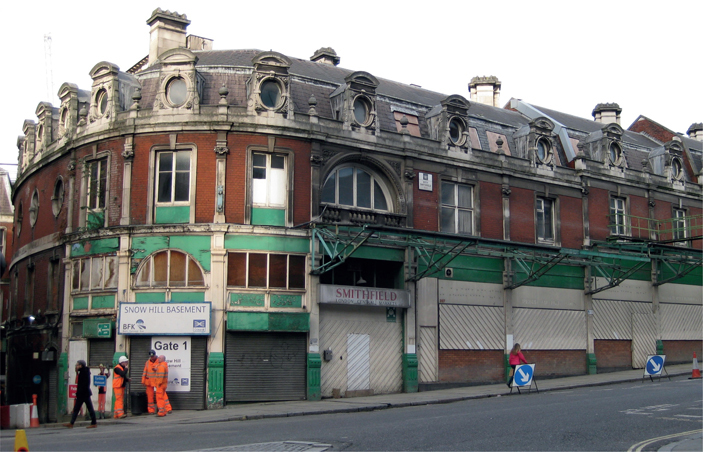
Figure 12.6
Smithfield Market, saved from demolition, is to become the Museum of London.
Handling significance
This chapter has referred to how current legislation and national policy relate to each other. The Historic Environment Good Practice in Planning Advice Note 220 helps with the practical application of the NPPF. In the preparation of a planning brief or masterplan, a study of significance should be able to provide guidance on which buildings should be saved and which might be redeveloped or altered without harm to that significance.
A brief or masterplan can also suggest the future pattern of development, which might be the recreation of a lost street plan or continuing a pattern of plot widths. Below-ground archaeology might have significance that justifies considering a particular layout. The significance of heritage assets should be identified early and inform the design process. A heritage assessment may be required to accompany a planning application and to demonstrate how the historic interest has been taken into account. Information identifying and evaluating the heritage assets concerned is essential in considering a planning application. It will enable the decision-maker to analyse the effect of the development proposal on heritage assets.
Impact and harm
The main factors to be taken into account in analysing the impact are the value of the heritage assets concerned and the scale of change that would affect them. The impact can range from the demolition of a listed building to minor alterations to an unlisted building in a conservation area, or harm to the setting of a heritage asset. Knowledge and experience will be useful in making the assessment. Figure 12.6 shows Smithfield Market, where proposals for an office and retail development on the site were dismissed following a public inquiry because the amount of demolition was considered to constitute ‘substantial harm’. The complex of buildings is now to be converted to become the Museum of London.
Conflicts may arise between conservation and urban design objectives. A typical example might be the reuse of a historic institutional site, part of the character of which might be its enclosure by high boundary walls or railings. The proposed change of use might create the opportunity to provide more permeability and public access. The challenge will be to resolve any apparent conflicts in light of the information relating to significance. Similarly, modern demands for large internal spaces and new forms of living/working might not be practical within an historic building; where original interior features and layouts of a building have been lost or have low significance, but its frontage makes an important contribution to local character and identity, a decision may need to be made as to how best to retain historic significance while allowing positive reuse. A compromise but controversial approach can be to keep the historic facade, but build a new building behind it, as shown in Figure 12.7.
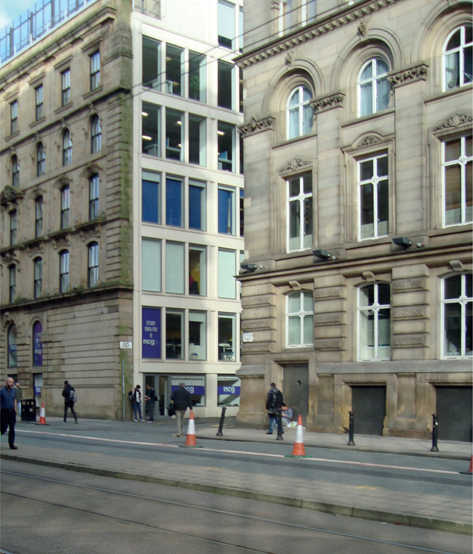
Figure 12.7
Constructing a new building behind a historic facade.
What the NPPF Says
‘… to achieve sustainable development, economic, social and environmental gains should be sought jointly and simultaneously through the planning system.’ (Paragraph 8)
Pursuing sustainable development involves ‘contributing to protecting and enhancing our natural, built and historic environment’ and ‘seeking positive improvements in the quality of the built, natural and historic environment …’ (Paragraphs 7 and 9)
‘Significant adverse impacts … should be avoided and, wherever possible, alternative options which reduce or eliminate such impacts should be pursued.’ (Paragraph 152)
Where adverse impacts are unavoidable, ‘this harm should be weighed against the public benefits of the proposal, including securing its optimum viable use.’ (Paragraph 134)
Although the NPPF sets the bar high in terms of the definition of ‘substantial harm’, a number of planning appeal decisions indicate that considerable weight may still be given where the harm is less than substantial.
The NPPF (Paragraph 137) also encourages new developments within conservation areas and World Heritage Sites and their settings to enhance or better reveal their significance. Such proposals should be treated favourably.
Enabling development
The viable use of a site is the key concept underlying the process of enabling development. Exceptionally, development may be permitted in unusual cases where it would otherwise be in conflict with planning policy, but the overall benefit to the heritage asset justifies the proposal, and the future conservation of the heritage asset is secured. For example, development might be permitted in the grounds of a listed building to subsidise its repair and reuse. This would not apply, for instance, where there is evidence of deliberate neglect of the asset or where the setting of the building is compromised – strict rules apply. Detailed advice is available from Historic England (Historic Environment Good Practice in Planning Advice Note 4: Enabling Development).
Setting
‘Significance derives not only from a heritage asset’s physical presence, but also from its setting’, the NPPF’s glossary explains, and setting has become an increasingly controversial issue. It involves not only the settings of listed buildings but also those of any other heritage assets, be they conservation areas, registered parks and gardens, or scheduled ancient monuments. Many current cases that are being dealt with by appeal or call-in relate to wind and solar farms, and tall buildings. Again, Historic England provides detailed guidance.

Figure 12.8
Historic environments can be enriched by new features as shown here at Spitalfields, London.
Building in context
Heritage, architecture and urban design often come together when development is being carried out in a historic context. Figure 12.8 shows a listed church with public-realm improvements, works of art and new buildings. More often than not, though, there is less conflict between urban design principles and the historic character of an area than might be apparent. The issue is often the priority being given to one urban design objective over another. The most difficult issue to deal with is architectural style. It is easy to be drawn into arguments about style, but analysing the proposal in terms of significance and urban design can at least bring some degree of objectivity to the discussion.
Heritage statements
A heritage statement can be part of a design and access statement, or a separate document. Whether you are commissioning or evaluating one, you may want to consider the following:
- Who is the author, and what are their qualifications?
- How much original research is there?
- Is the statement merely repeating policy or guidance?
- Have all the relevant issues been dealt with?
- How has the statement dealt with the issue of significance?
- Has the proposed development been analysed in terms of accepted policy and technical advice?
- Is the statement objective, or does it contain unchallenged value statements?
- What is it not saying; is it missing important elements?
Heritage at risk
Historic England and many local authorities compile lists of heritage assets at risk. Assets identified as being at risk are those in poor condition that have seemingly intractable problems due to a number of factors, such as location, under investment, ownership and difficulty of reuse. Despite the challenges they present, with the right will and cooperation they can contribute positively to an area’s improvement or regeneration. National policy requires a proactive approach: Paragraph 126 of the NPPF states that ‘local planning authorities should set out a positive strategy for the conservation and enjoyment of the historic environment, including heritage assets most at risk’.
Conservation advice
Planning departments need in-house specialists to steer a way through the conservation maze. However, since 2007 the numberof conservation officers employed by local authorities has dropped by 33%.21
Historic England’s resources are also limited, and its advisers are able to get involved principally with applications such as those affecting Grade I- and II*-listed buildings, scheduled monuments and conservation areas representing major sites.
Historic England will also provide advice on local plans, neighbourhood plans, masterplans and supplementary planning documents, as well as characterisation documents, where appropriate. While planners should be able to deal with basic conservation issues, failure to get the right professional advice may lead to complaints to the ombudsman or judicial review. It can therefore be useful to have access to consultancy services if in-house advice is not available.
As well as the Historic England publications referenced here, a number of Historic England Advice Notes cover topics such as conservation areas and making changes to historic assets. These can be downloaded from the Historic England website. An excellent guide to building conservation is the British Standards publication Guide to the Conservation of Historic Buildings (BS7913: 2013).
Consider
- Just about everywhere has history. Planners and designers should look to use this as a positive force informing and supporting developments, rather than a brake on what can be done.
- Because urban design is based on an understanding of the characteristics of successful places, and historic areas that have survived tend to be successful and have these characteristics, there is synergy between good management of heritage and good urban design.
- Historic conservation, as a sister process to planning, includes many useful terms and concepts, such as heritage asset, significance and substantial harm. This chapter gives an introduction to these, and Historic England’s documents provide more information and advice.
- Historic conservation is a detailed and professional field of work. Its experts have a great deal of knowledge both of building and design details from different eras, and of the concepts and policies to be applied to their management. Although expert input is becoming harder to access, it should be used whenever possible to support planning work.
